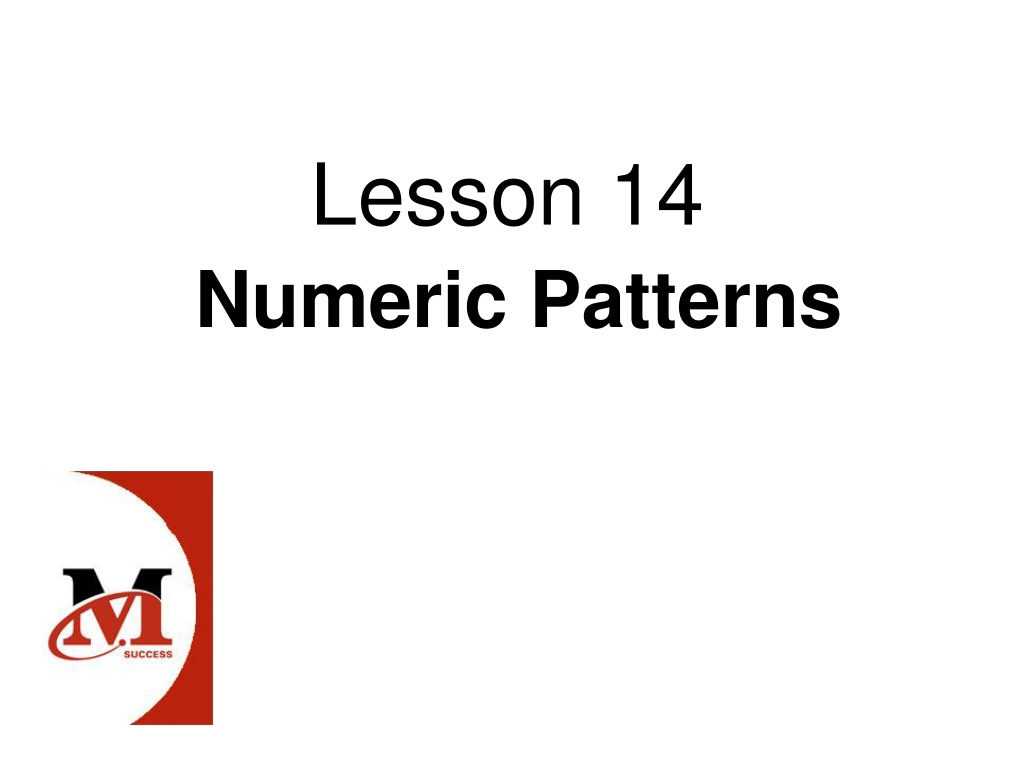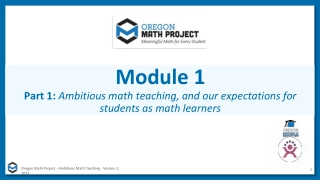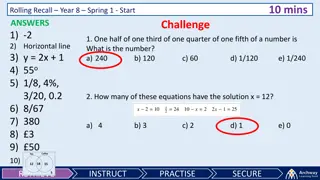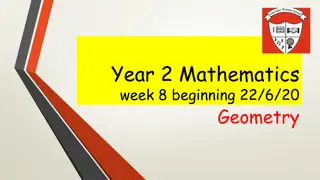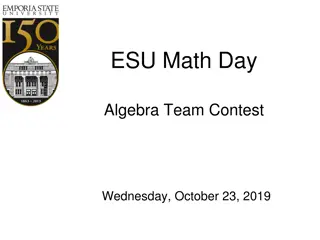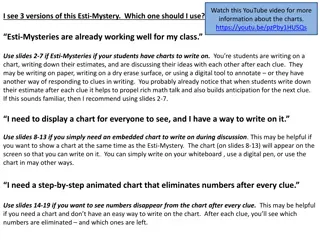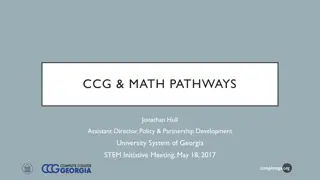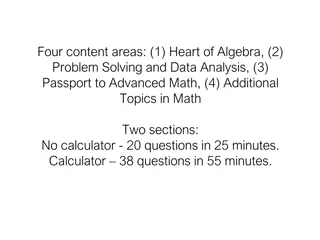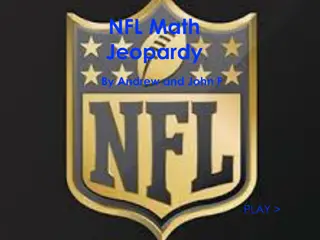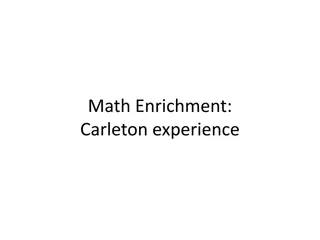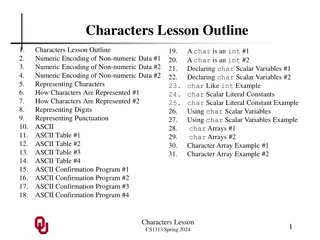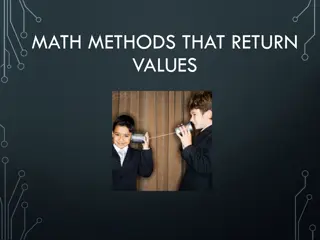Understanding Numeric Patterns in Math
In this lesson on numeric patterns, students will learn to identify, analyze, create, and extend patterns. The content covers topics such as multiples, skip counting, identifying errors in patterns, and sequencing numbers. Essential questions and practice exercises are included to reinforce learning.
Download Presentation

Please find below an Image/Link to download the presentation.
The content on the website is provided AS IS for your information and personal use only. It may not be sold, licensed, or shared on other websites without obtaining consent from the author. Download presentation by click this link. If you encounter any issues during the download, it is possible that the publisher has removed the file from their server.
E N D
Presentation Transcript
Lesson 14 Numeric Patterns
[OBJECTIVE] The student will identify, analyze, create, and extend numeric patterns.
[MYSKILLS] Multiples to skip count
[ESSENTIALQUESTIONS] 1. What are the characteristics of a numeric pattern? 2. How can we extend a numeric pattern? 3. How can we find missing terms in a numeric pattern?
[LESSON] SOLVE Jason had 24 numeric pattern problems for homework last night. He completed his homework in 45 minutes. He had trouble with one question where he had to complete a pattern. Look at the following numerical pattern. What is Jason s error? 4, 8, 12, 16, 24, 28, 32 S Study the Problem Underline the question. This problem is asking me to find the error Jason made in completing the pattern.
[Cooperative Pairs] Partner A Partner B
Skip Counting Skip count by twos! What was the first number or term? What was the second number or term? 4 6 2 10 12 14 20 22 24 30 32 34 36 40 42 44 46 8 16 26 28 38 48 50 18
Skip Counting Skip count by fives! 10 15 20 5 25 30 55 35 40 45 60 65 70 50 75 85 90 95 100 How is this pattern different from the first? How many students had a chance to 20 STUDENTS How long was the list of numbers? 20 Numbers 80 The pattern counts by fives and the first counted by twos. respond? What was the first number or term? What was the second number or term?
Patterns Are these cards in the correct order to show the multiples of 2? 8 20 12 4 14 10 18 6 16 2
Patterns No. Let s put them in order! 8 20 12 4 14 10 18 6 16 2 2 4 6 8 10 12 14 16 18 20
Patterns and Sequences A sequence is the list of numbers for a numeric pattern. Numeric Patterns Sequence The list of numbers for a numeric pattern 2,4,6,8,10,12 Definition: Example:
Patterns and Sequences Sequence The list of numbers for a numeric pattern 2,4,6,8,10,12 Definition: Example: Term each number Definition: in the sequence Example: in the sequence is 2. The first term
Patterns Add 2 to the previous term to get the next term! +2 +2 +2 +2 +2 +2 +2 +2 +2 2 4 6 8 10 12 14 16 18 20
Patterns and Sequences Term Definition: in the sequence. each number What rule was followed to determine the numerical pattern? The first term Example: in the sequence is 2. Rule a relationship Definition: among the terms Example: The rule is +2.
Numeric Patterns 8 32 2 16 4 1 1 2 What is the smallest term? What is the second smallest term?
Numeric Patterns +1 OR 2 1 2
Numeric Patterns 8 32 16 4 1 2 4 What is the next smallest term?
Numeric Patterns +1 OR 2 +2 OR 2 1 2 4 Have we established a single rule? No. Find the pattern between the next terms.
Numeric Patterns 8 32 16 1 2 4 8 What is the next smallest term?
Numeric Patterns +1 OR 2 +2 OR 2 +4 OR 2 2 2 1 2 4 8 16 32 Have we established a single rule? Yes. Multiply by 2!
Finding a Rule Step 1: Look at the smallest term. Step 2: Look at the 2nd term and determine rules that could apply from the 1st to 2nd term. Step 3: Look at the 3rd term and determine rules that could apply from the 2nd to 3rd term. Step 4: Continue to look at the order of the terms until all rules but one can be eliminated.
Extending Numeric Patterns +6 OR 3 3 3 3 3 3, 9, 27, 81, 243, 729 Which of these rules works between the second and third term? Multiply by 3
Extending Numeric Patterns -64 OR 2 2 2 2 2 128, 64, 32, 16, 8, Which of these rules works between the second and third term? Divide by 2 Does that rule work between the third and fourth terms? 4 YES!
Missing Terms +1 OR 2 +2 OR 2 2 2 2 1 2 4 8 16 32 Multiply by 2 Is 32 the fifth term? No, we have a missing term!
Record the Missing Term DECK PATTERN 1, 2, 4, 8, 16, 32 TEACHER DECK 2
Missing Terms +3 OR 2 +3 +3 +3 +3 3 6 9 12 15 18 Add 3! Is 15 the fourth term? No, we have a missing term!
Numeric Patterns +3 +3 +3 +3 +3 3 6 9 12 15 18 What do you notice about the 1st, 3rd, and 5th terms? They are all odd (3, 9 and 15) What do you notice about the 2nd, 4th, and 6th terms? They are all even numbers (6, 12 and 18) What can you conclude from this? When you add two odd numbers the sum is even; when you add an even number and an odd number the sum is odd.
Record the Missing Term DECK PATTERN 1, 2, 4, 8, 16, 32 TEACHER DECK 2 TEACHER DECK 3 3, 6, 9,12,15, 18
Numeric Patterns 5 If this set of cards shows the number of terms in the pattern sequence, how many terms are in the sequence? 6 What must we know before creating a pattern? the rule If we use the rule multiply by 2 and begin the pattern with 5, what is the first term?
Numeric Patterns 5 10 20 40 80 160 2 2 2 2 2 Second term? Third term? Fourth term? Fifth term? Sixth term? If we remove 80, can we determine the missing term? YES! Follow the rule of multiplying by 2. 40 times 2 = 80
Patterns and Sequences 1. Extend the pattern: 1, 9, 17, 25, __ __ __ 33, 41,49 +8 9 +8 +8 +8 +8 +8 Add 8 Rule: Look at the first two terms and identify what rule might work, then look to see if the same rule applies for the third term. Make a prediction about all the terms. They will all be odd. Odd + Even = Odd
Patterns and Sequences 5. 33, 30, 27, 24, __, 18, 15, 12 21 -3 -3 -3 -3 -3 -3 -3 Rule: Subtract 3 Look at the first two terms and identify what rule might work, then look to see if the same rule applies for the third term. Make a prediction about the next term. It will be odd. Even Odd = Odd and Odd Odd = Even
Patterns and Sequences 7. Create a 6-term pattern sequence: 9, __ __ __ __ __ 15, 21, 27, 33, 39 +6 +6 +6 +6 +6 +6 Rule:
Numeric Pattern Foldable What does it look like? Finding the Rule Numeric Patterns Extending the Pattern Finding a Missing Term
SOLVE Jason had 24 numeric pattern problems for homework last night. He completed his homework in 45 minutes. He had trouble with one question where he had to complete a pattern. Look at the following numerical pattern. What is Jason s error? 4, 8, 12, 16, 24, 28, 32 S Study the Problem Underline the question. This problem is asking me to find the error Jason made in completing the pattern.
Jason had 24 numeric pattern problems for homework last night. He completed his homework in 45 minutes. He had trouble with one question where he had to complete a pattern. Look at the following numerical pattern. What is Jason s error? 4, 8, 12, 16, 24, 28, 32 O Organize the Facts Identify the facts. Eliminate the unnecessary facts. List the necessary facts. Numerical pattern: 4, 8, 12, 16, 24, 28, 32
L Line Up a Plan Choose an operation or operations. Addition Write in words what your plan of action will be. Look at the first two terms and decide what rule might be used to get from the first term to the second term. Decide which of the rules would work for the third term. Look at the next term to establish the rule. Use the rule to look at the rest of the terms. Decide which term is missing when the rule will not work from one term to the next.
V Verify Your Plan with Action Estimate your answer. Somewhere between 16 and 24 Carry out your plan. Rules for term 1 to term 2: either Add 4 or Multiply by 2 Rule for term 2 to term 3: Multiply by 2 will not work. Add 4 will work. Rule works for term 3 to term 4. Rule does not work for term 4 to term 5, so term 5 must be missing. 16 + 4 = 20 4, 8, 12, 16, 24, 28, 32
E Examine Your Results Does your answer make sense? (compare your answer to question.) Yes, because we are looking for Jason s pattern error. Is your answer reasonable? (compare your answer to the estimate.) Yes, because it is in the range of my estimate of somewhere between 16 and 24.
Is your answer accurate? (check your work.) Yes. Write your answer in a complete sentence. Jason s error was the missing term of 20.
[ESSENTIALQUESTIONS] 1. What are the characteristics of a numeric pattern? (It is a group of numbers that follows a pattern. It has a sequence that consists of terms.)
[ESSENTIALQUESTIONS] 2. How can we extend a numeric pattern? (Determine the rule and apply it to the terms to be extended.)
[ESSENTIALQUESTIONS] 3. How can we find missing terms in a numeric pattern? (Determine the rule and apply it to the terms in the pattern sequence. Determine where the missing term would be.)
Word Wall Numeric Pattern Sequence Term Rule Extending the Pattern Missing Term
Lesson 14 Numeric Patterns
